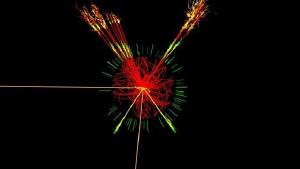Blog
Reading Between the Lines
8 October 2014
 CERN/LHC/CMS/ATLAS
CERN/LHC/CMS/ATLASYesterday I talked about the Higgs, and how its discovery has led to a flurry of articles about how it might apply to astrophysics. So today here’s another example, and this one’s interesting because it’s not simply trying to use the Higgs to explain known phenomena, it’s trying to use astronomical observations to understand things about the Higgs. It comes from a paper recently published in the Astrophysical Journal, and concerns the spectra of white dwarf stars.1
As you might recall, a white dwarf is the remnant of a solar-mass star that has exhausted its ability to fuse elements in its core. Without a source of heat, the star is compressed by gravity to the point where only the pressure of electrons in atoms can prevent it from collapsing further. When our own Sun eventually dies, it will become a white dwarf roughly the size of Earth. The nice thing about white dwarfs is they usually still have remaining heat from their formation, so they glow brilliant white. This means we can observe the light emitted by them fairly easily. We can even observe the line spectra of white dwarfs, which we can use for things like testing general relativity.
Typically when we talk about emission lines, we mean the ones caused by electrons shifting their position in an atom or molecule, but there are also emission lines due to protons and neutrons in the nucleus of an atom. These latter lines are similar to the usual emission lines, but they are governed by the strong nuclear force rather than the electromagnetic force. Studying nuclear emission lines lets us understand the behavior of nuclear forces.
That’s where white dwarfs come in. The emission spectra of white dwarfs contain both traditional emission lines due to electrons, and nuclear emission lines due to protons and neutrons. The reason this is important is that protons and neutrons are much more massive than electrons, so the Higgs field interacts with them differently. As a result, any shift in the behavior of the Higgs will affect the nuclear line spectra differently than the regular one.
What the authors are interested in is whether the Higgs interacts with strong gravitational fields. That isn’t something that we can currently test in the lab, but it could be seen in the strong gravity of a white dwarf. In analyzing white dwarf spectra, the authors find no evidence of any Higgs-gravity interactions, but they are able to determine an upper limit on the strength of any such interaction.
Mainly this work is a proof of concept. Given combination of high-density mass and strong gravitational fields seen in objects like white dwarfs and neutron stars, Higgs interactions may play a role in their evolution and behavior. It is something we can at least try to look for, and this is a first step in that direction.
Onofrio, Roberto, and Gary A. Wegner. “Search for Higgs shifts in white dwarfs.” The Astrophysical Journal 791.2 (2014): 125. ↩︎